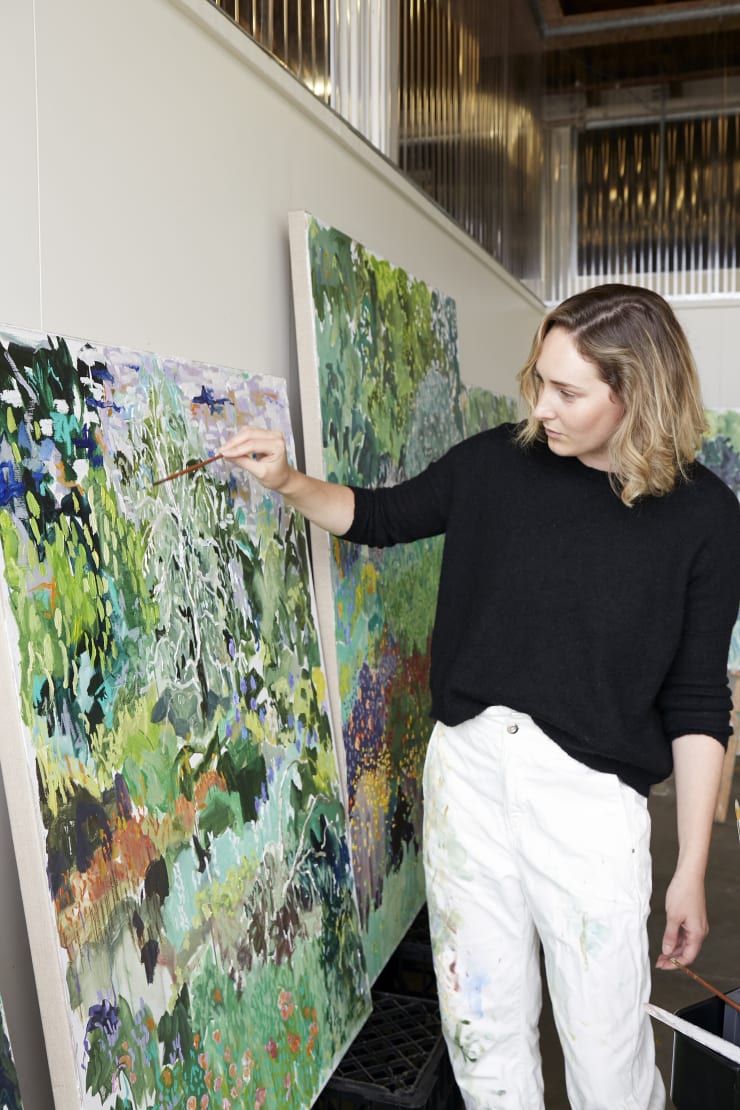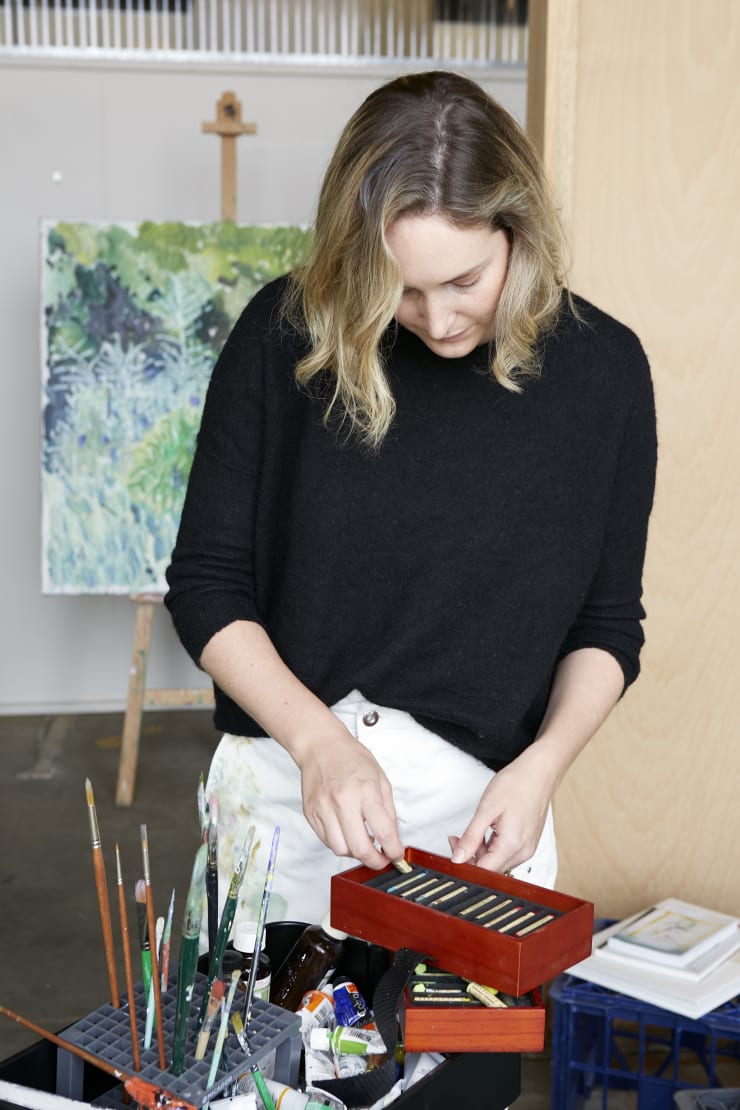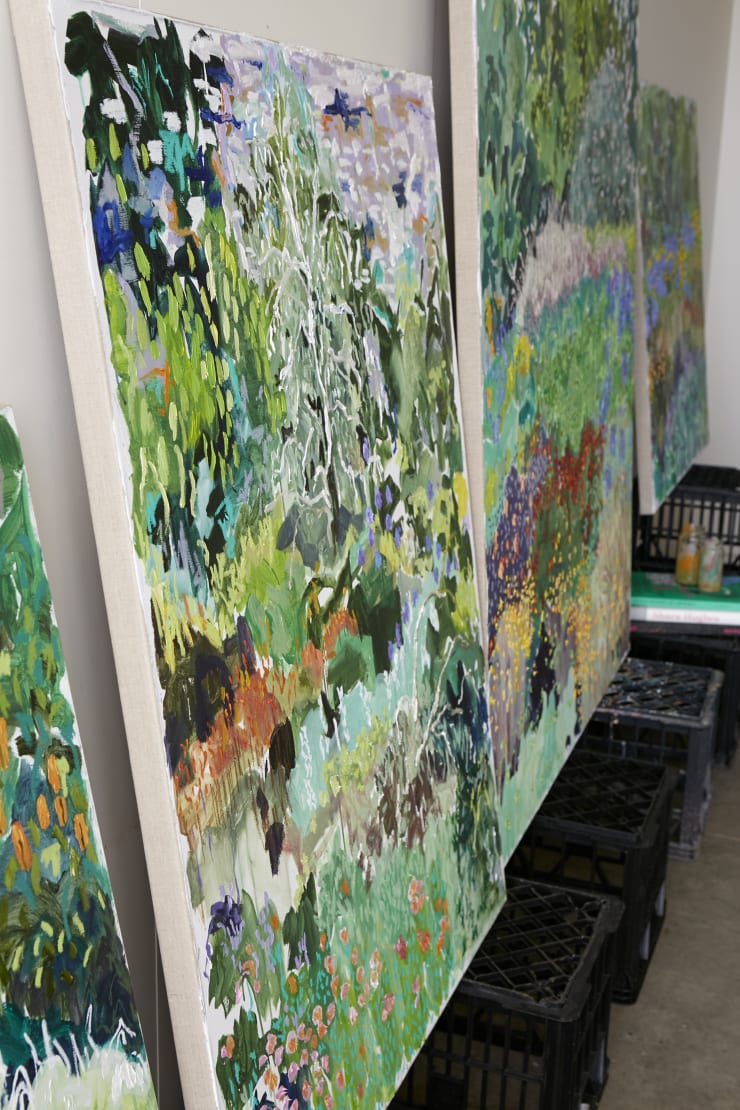OTOMYS: We are curious to hear more about your process of becoming at peace with contradiction through your artistic process. In your process, do you find the art-making – the physical act of applying paint onto linen— to be the moment in which you are the most mindful?
Emma Itzstein: Psychologically, this has been a really personal discovery process, however I feel like it's something so many can connect to in their own time. I found the last few years to be extremely taxing mentally, like many during these times of uncertainty, and doing some work with a psychologist I have learned a lot about unhelpful thinking patterns which were contributing to me feeling overwhelmed. I spend a lot of time in my head ruminating over sticky and obsessional thoughts which revolve around questions that are hard to define and impossible to answer. It can be an unhealthy place to be; seeing the world through dichotomy and getting anxious about not having the answers, or feeling like there isn’t any; however in my art practice I am able to fully embrace the tension between uncertainty and control and all the nuance in between. The infinite possibilities that the practice of painting offers is like the ultimate exposure therapy to the discomfort of uncertainty and surrendering to chance. I start my linens with a loose approach of instinct and impulse and then work back into the picture with more intent, mindfulness and consideration - trying to embrace, rather than avoid or conceal, the imperfections of the foundation I have created. Paintings don’t say one thing, they say many… and often things that are contradictory or absurd - I find this playfulness and multiplicity exciting and hopeful. This dialogue or dance of action and reaction in the process of painting, gives me the agency to explore a practice that I’m trying to emulate in my perspective to life outside the studio.
OTOMYS: What is it about nature, do you think, that makes it a good subject matter for exploring the human psyche?
Emma Itzstein: Oh my - everything? I think nature could probably answer all the questions we have about life - patience, growth, beauty, decline, resilience, rebirth, renewal, transformation, respect… I think it's both our teacher and mirror. It kinda sucks that it often seems we’re not very awake students. I find it so interesting how we literally have this ultimate spiritual metaphor right under our nose.
OTOMYS: In your recent works you’ve looked towards the Royal Botanic Gardens as a hub to many in these times of solitude that have emerged due to the multiple lockdowns. Did you have a place you liked to go to during lockdown in Geelong?
Emma Itzstein: I’ve used the Royal Botanic Gardens as a symbol to represent publicly enjoyed places more generally. Public spaces were ripped of their human energy and I’m interested in how we collectively fill a place with our transient humming presence. How we create and impact collectively, not alone, both in a single moment and through history and into the future. To be honest, with my first child born in May 2020, as a new mother I didn't tend to go further than my local park. Occasionally I’d make it to the Barwon River which is a beautiful place to walk in Geelong.
OTOMYS: You also mention being inspired by instrumental music. Are there any specific pieces/composers you have been enjoying recently?
Emma Itzstein: I listen to a lot of Bon Iver and Tash Sultana while I paint. I’m really inspired by their instrumental approach - the versatility of variety of sound - and sort of applying this to mark making. I find it quite hypnotic and the looping in their music is really interesting to me - how this is sort of like repetition and pattern. They fuse lots of genres of music and I’m drawn to that playfulness and experimentation. There are so many parallels in music and painting and given I was exploring rhythm, beat, atmosphere and vibration in this body of work, I really tried to let the music come into it.
OTOMYS: You talk about being interested in how spaces become populated with energy and rhythm through the presence of people. Is human presence in nature something you’d be interested in exploring in future works?
Emma Itzstein: Definitely. I’m about to embark on a series of, predominantly, figure-in-the-landscape work. Many will be mixed media on digital print. I've been really inspired by Cecily Brown's latest work released through Blum and Poe, which embraces 'infinite potentiality' by digitally capturing a painting at a particular moment, reproducing it in print and then painting over it to create new paintings; "revisiting personal thoughts and objectives through the lens of hindsight" (Art Limited 2022). It will mark a bit of a shift in my practice from an aesthetic or formalist point of view, but one that continues to explore ideas of multiplicity and infinite possibilities; in the way of stories, context, history, hindsight and is an ode to influence - both of the past and contemporaries - personally and collectively. I am very excited to make the work and see how these ideas crystallise as I make the work.




